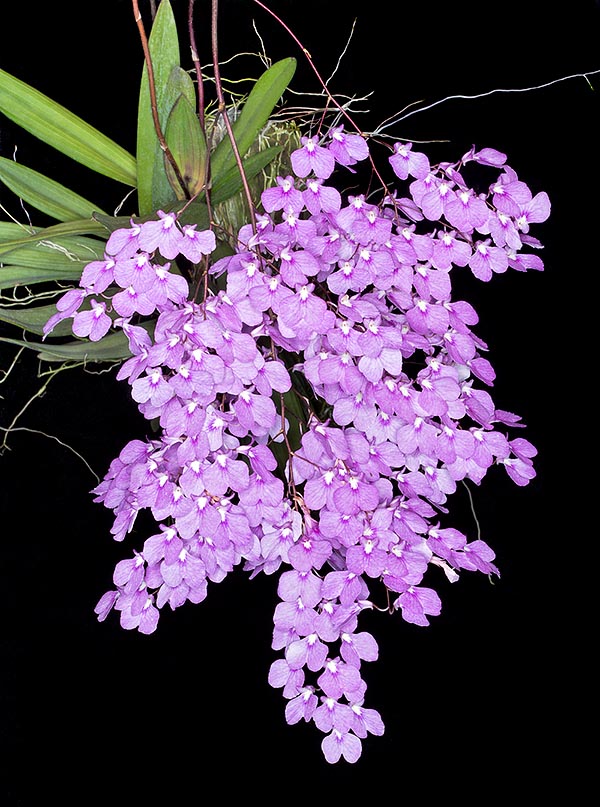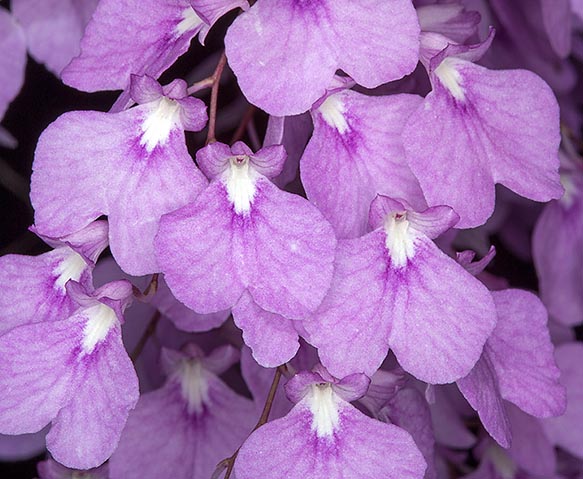Family : Orchidaceae

Text © Pietro Puccio

English translation by Mario Beltramini

The Ionopsis utricularioides is an epiphyte, rarely terrestrial, of tropical America © Giuseppe Mazza
The name of the genus is the combination of the Greek substantive “ἴον” (ion) = violet (Viola sp.) and “ὄψις” (opsis) = look, with reference to the shape of the flower; the specific name is the combination of the name of the genus Utricularia and of the Greek suffix “-οειδής” (-oeidés), from “εἶδος“ (êidos) = shape, look, due to the resemblance of the flowers with those of some species belonging to the aforementioned genus.
Common names: delicate ionopsis, delicate violet orchid (English); orquídea do café (Brazil); dancing ladies (Jamaica); angelitos (Puerto Rico).
The Ionopsis utricularioides (Sw.) Lindl. (1826) is an epiphytic species, rarely terrestrial, cespitous, with flat ellipsoid pseudobulbs, 1-3 cm long, often completely hidden by the foliar bases, provided or not of an apical leaf. Basal leaves, in number of 2-4, linear-lanceolate to oblong-linear, 3-15 cm long and 0,6-1,8 cm broad, coriaceous, of green colour often suffused of brown-reddish in conditions of high luminosity.
Racemose or paniculate inflorescences from the base of the pseudobulb, 20-70 cm long, erect or arcuate, bearing numerous flowers of colour from white with intense pink veins and pink shades, to pink, lavander or purple. Oblong-elliptic sepals, 4-6 mm long and 1-3 mm broad, the two lateral merged at the base forming a bilobed cavity behind the labellum, oblong petals with obtuse or pointed apex, 5-7 mm long and 3-4 mm broad, obcordate labellum, emarginate, with entire margin or crenulate, 8-17 mm long and 8-18 mm broad, provided of two yellow tubercles at the base. The fruit is an ellipsoid capsule 15-20 mm long and of about 5 mm of diameter. It reproduces by seed, in vitro and division.
One of the most diffused American orchids with the long blooming period and the tiny delicate flowers produced abundantly, requires high luminosity, medium-high temperatures in summer, 20-32 °C, slightly cooler in winter with lowest ones preferably not under the 16 °C, high ambient humidity, 75-90%, and air maintained in constant movement. Frequent and abundant waterings during the growth period, utilizing rain water, demineralized or by reverse osmosis, slightly more spaced in winter, but without allowing the substratum to dry up completely, and monthly fertilizations, from spring to autumn, utilizing a hydrosoluble balanced product, with microelements at ¼ of the dosage reported on the package.

Very common in nature, is appreciated in the horticultural world due to the rich long lasting 20-70 cm inflorescences. White flowers with pink veins and pink shades, but also lavander or purple varieties © Giuseppe Mazza
The species is reported in the appendix II of the CITES (species whose trade is internationally ruled).
Synonyms: Epidendrum utricularioides Sw. (1788); Dendrobium utricularioides (Sw.) Sw. (1799); Ionopsis pulchella Kunth (1816); Iantha pallidiflora Hook. (1824); Cybelion pallidiflorum (Hook.) Spreng. (1826); Cybelion pulchellum (Kunth) Spreng. (1826); Cybelion utriculariae Spreng. (1826); Epidendrum crenatum Vell. (1831); Ionopsis pallidiflora (Hook.) Lindl. (1836); Ionopsis paniculata Lindl. (1836); Ionopsis tenera Lindl. (1836); Scaphyglottis pallidiflora (Hook.) Lindl. (1839); Cybelion tenerum (Lindl.) Steud. (1840); Ionopsis gardneri Lindl. (1851); Ionopsis zonalis Lindl. (1851); Ionopsis tenera var. effusa Lindl. (1852); Ionopsis tenera var. tomentosa Lindl. (1852); Ionopsis tenera var. violace a Lindl. (1852); Epidendrum paniculatum (Lindl.) Rchb.f. (1865); Ionopsis paniculata var. maxima L.Linden & Rodigas (1887); Epidendrum calcaratum Sessé & Moc. (1894); Ionopsis utricularioides f. latifolia Urb. (1903); Ionopsis utricularioides var. angustifolia Cogn. (1904); Ionopsis utricularioides var. parviflora Schltr. (1922); Epidendrum sessei Hoehne (1952); Ionopsis utricularioides var. virginalis L.C.Menezes (1993); Ionopsis utricularioides f. virginalis (L.C.Menezes) Christenson (1996).
→ For general notions about ORCHIDACEAE please click here.
